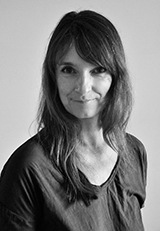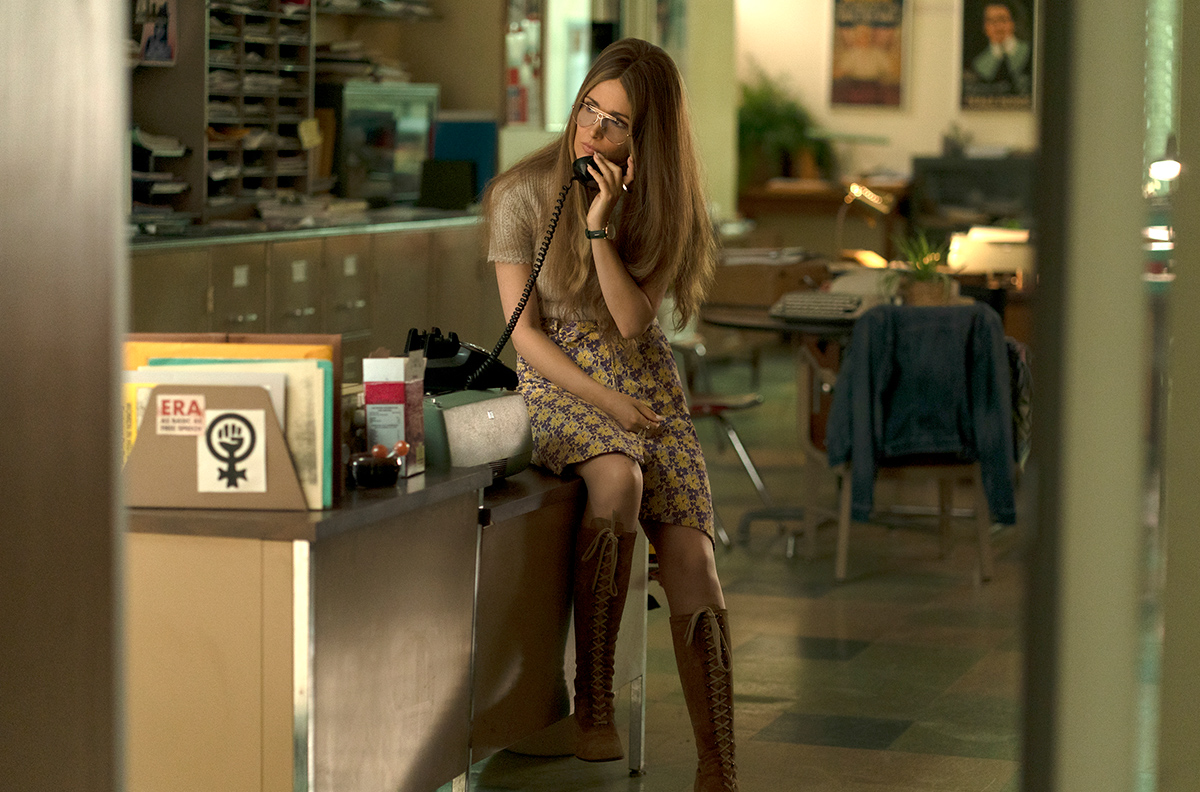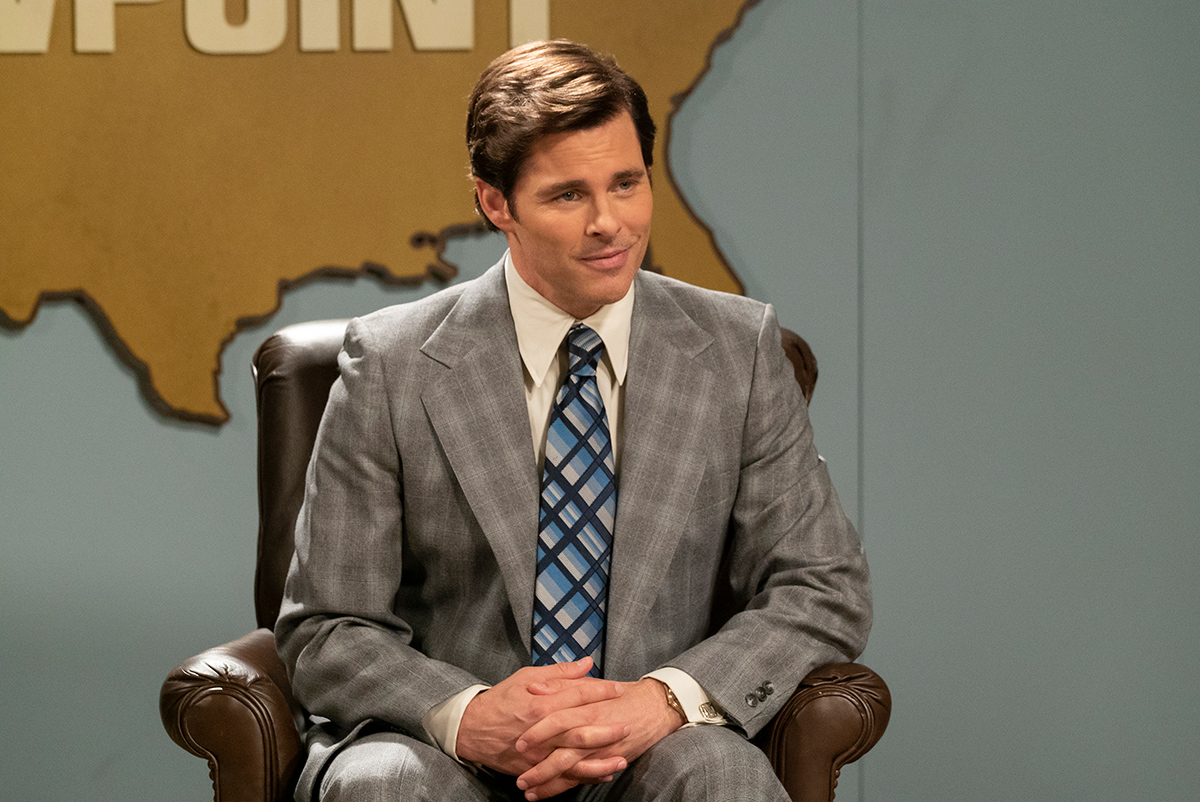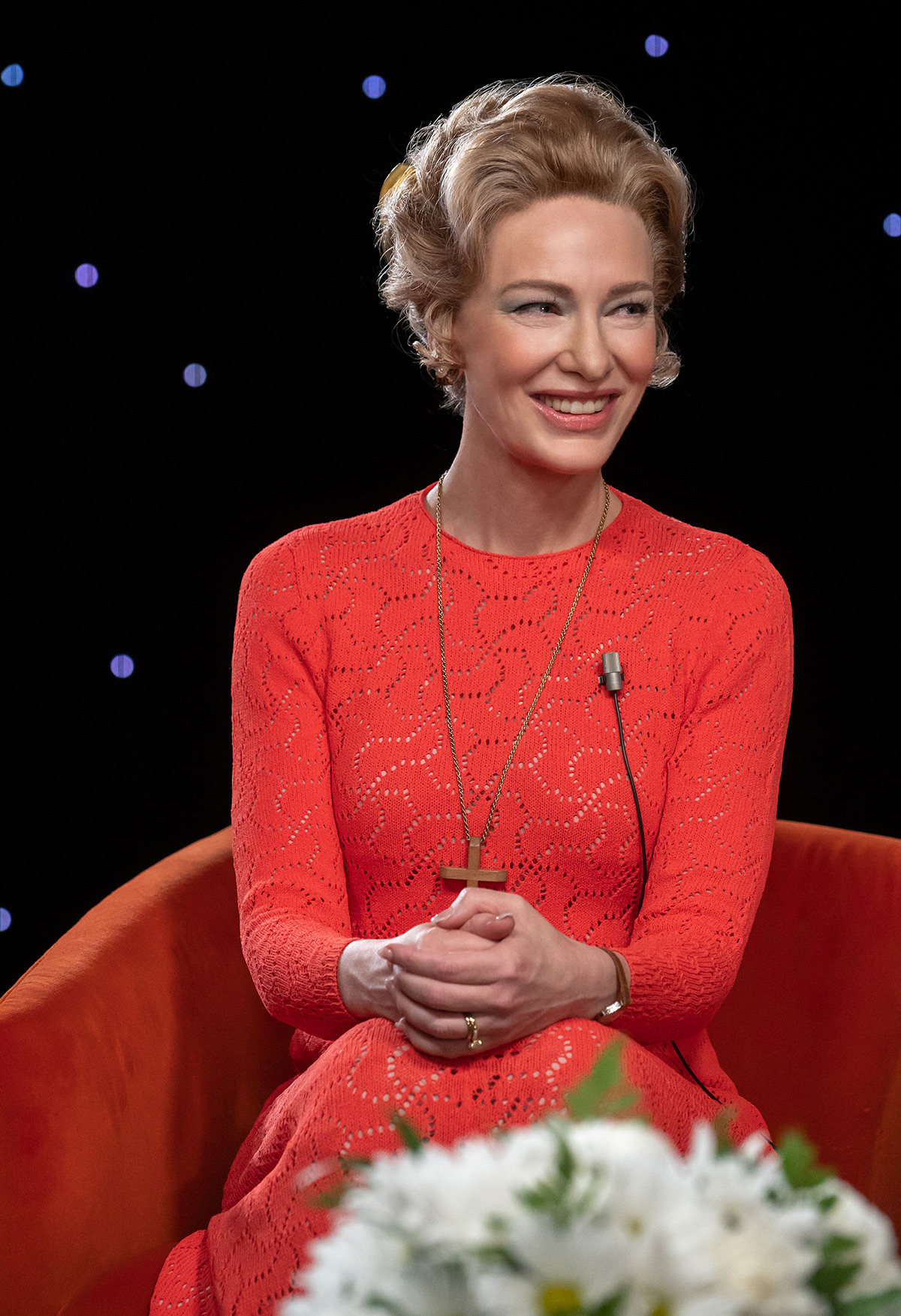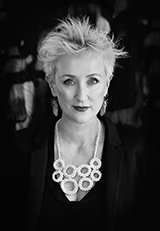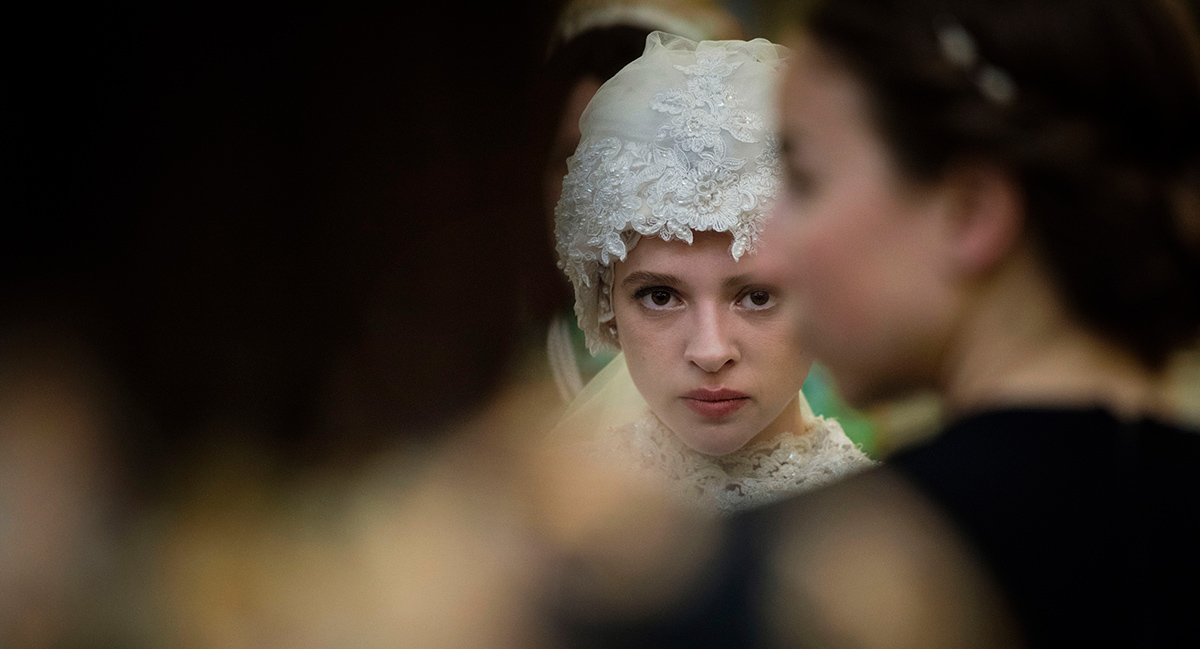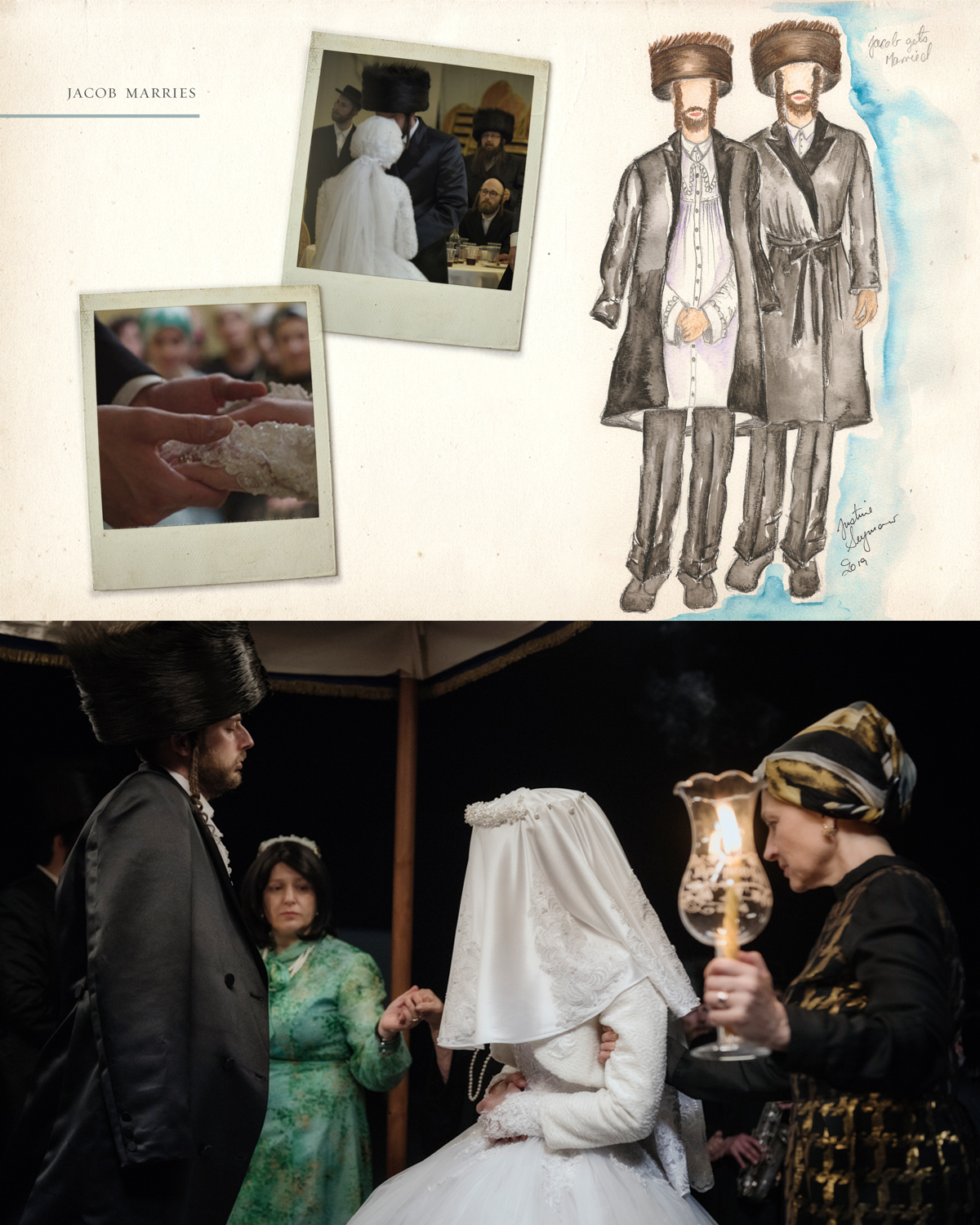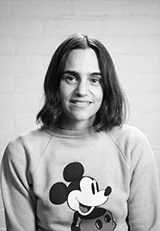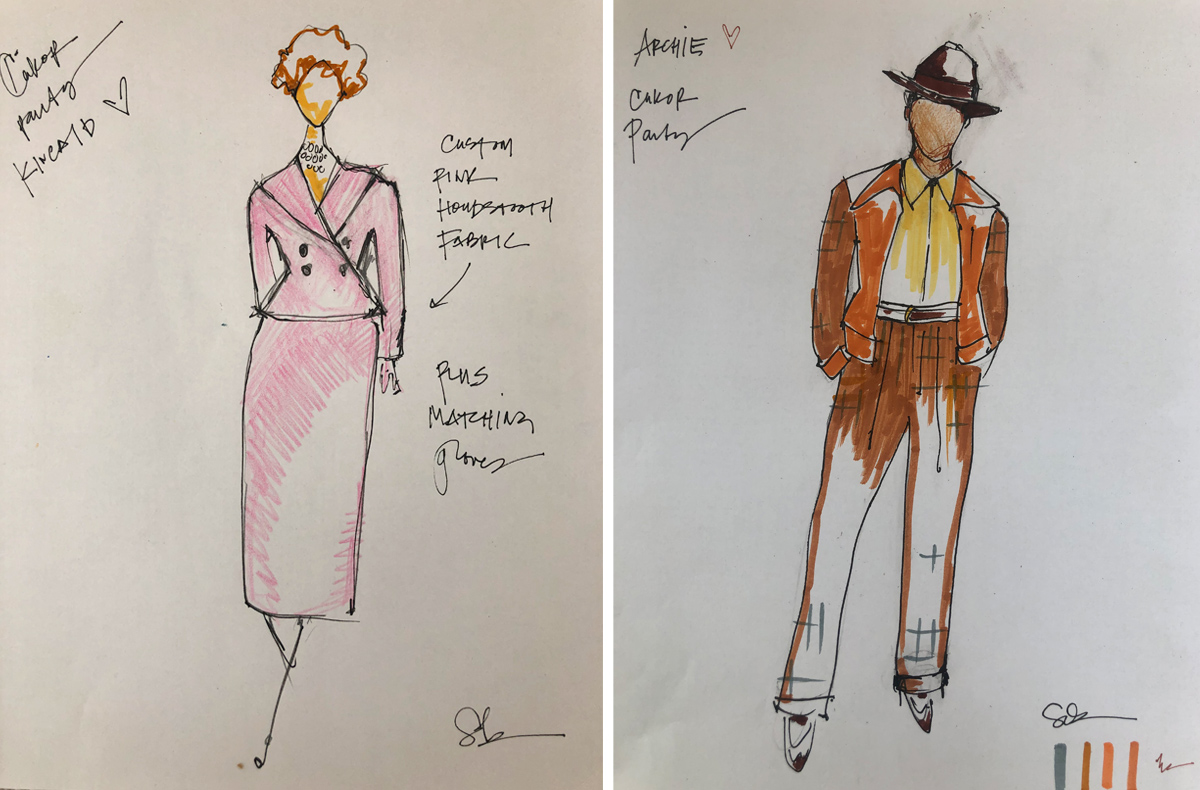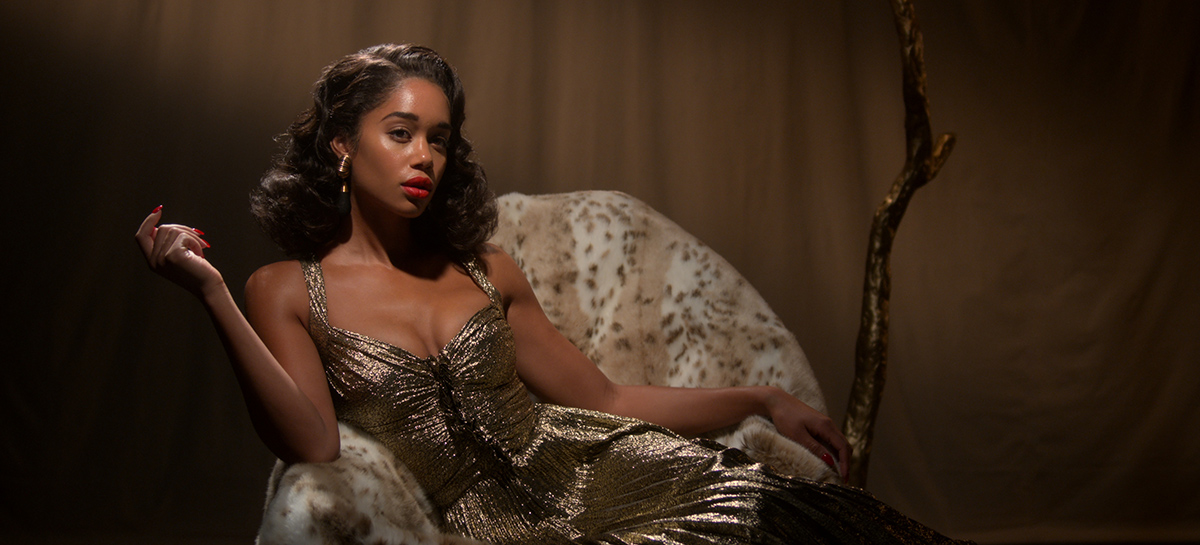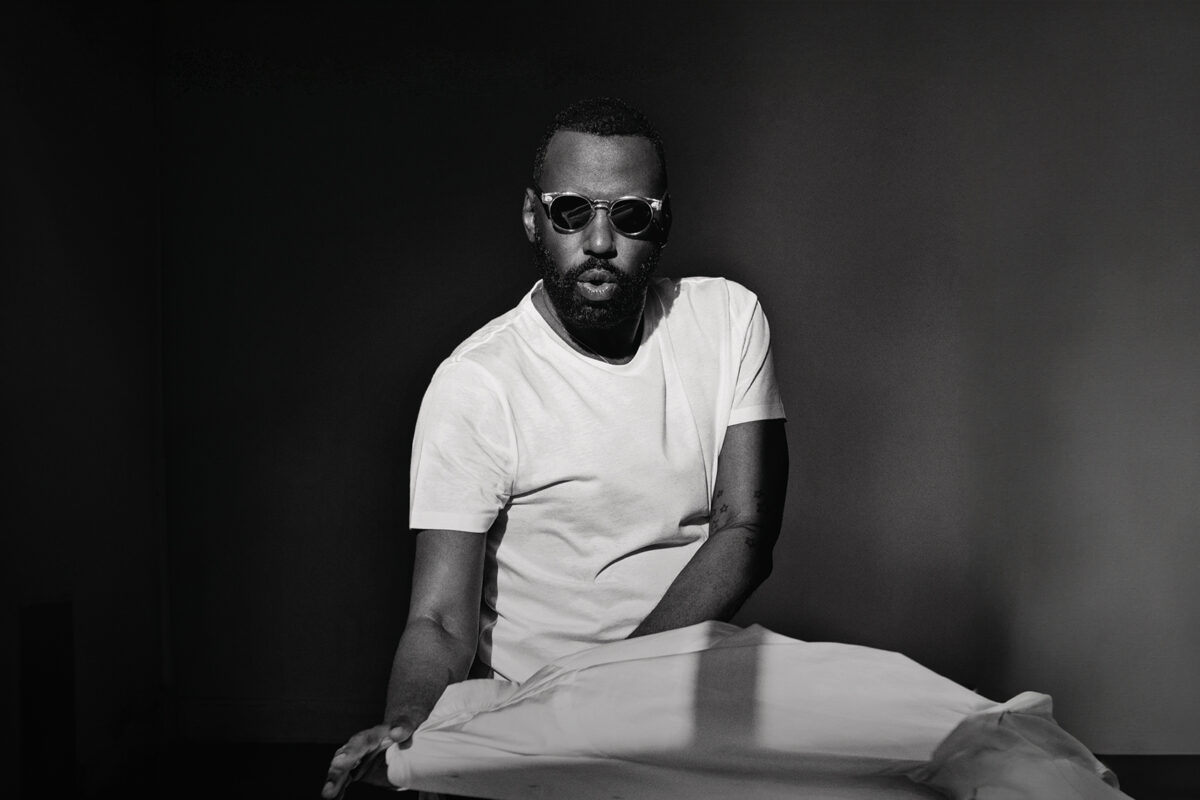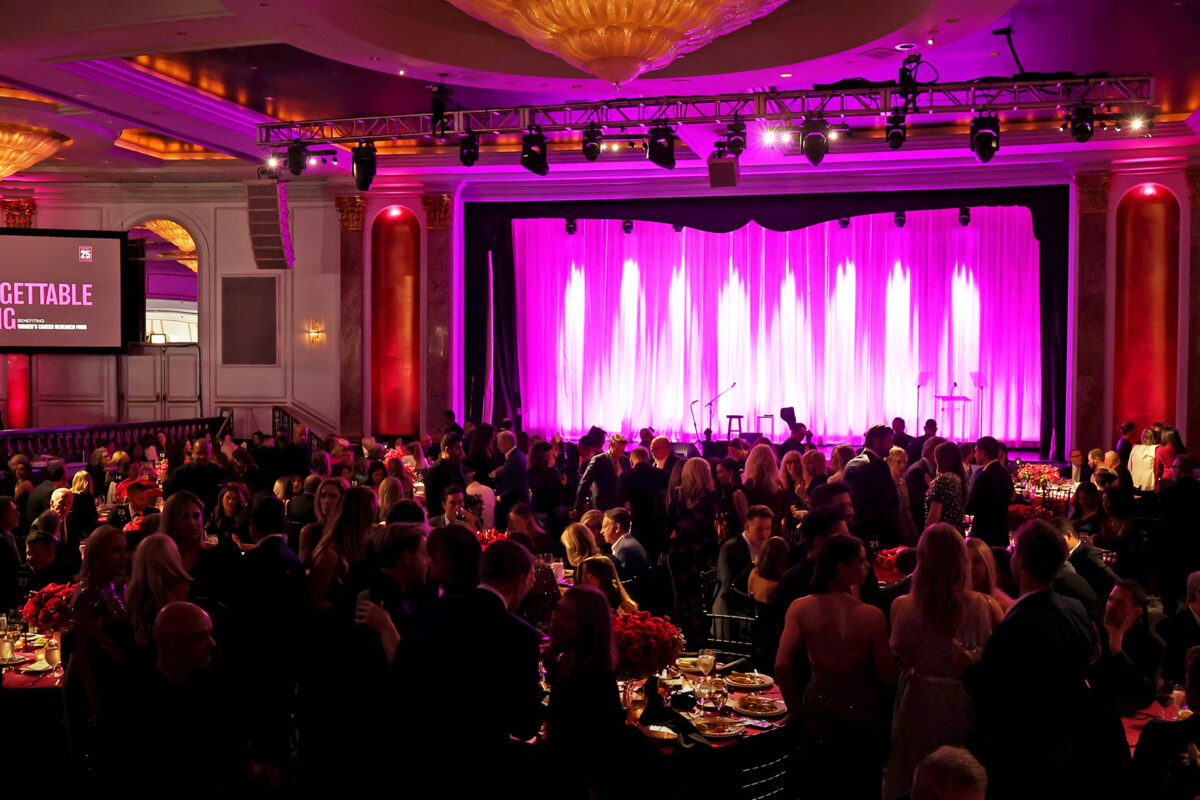Meet the costume designers of Mrs. America, Unorthodox and Hollywood
Words by ALISON EDMOND
While we are currently consuming more TV series than ever before, great costume design on the smaller screen is truly having its own moment in the spotlight. Whether it’s the draped cardigans and pussybow blouses of ’70s drama Mrs. America, the high waists and camp collars of Hollywood in the ’40s, or the lace bridal gowns and fur shtreimel hats of a modern-day Hasidic community in Unorthodox, fashion matters, and the designers behind these three revered series know how vital appearances are in a supporting role to the characters.
Before a word has even been uttered by an actor, the mood of the wardrobe is one of the key elements to setting the tone for a series. The strength in the message sent by what an actor wears, whether it be political, historical, or emotional, is created through the artistry displayed by the costumer. Bina Daigeler (Mrs. America), Justine Seymour (Unorthodox) and Sarah Evelyn (Hollywood) did extraordinary amounts of research with painstaking attention to detail in advance of their latest shows. We ask them about their methods and inspirations, and what they’ve been watching during quarantine.
• • • • •
BINA DAIGELER
Costume designer for: Mrs. America
Other credits: Mulan, The Zookeeper’s Wife, Snowden and Narcos
In Hulu’s Mrs. America, Daigeler re-created the looks for all the differing and distinct power women from the late ’60s and early ’70s, who were fighting on either side of the ratification of the Equal Rights Amendment. Their clothing wasn’t the most important thing in these women’s lives, but at the same time, what they wore needed to align with the messages they wanted to deliver.
As a viewer, but someone who is also in the fashion business, I find the wardrobe to be vital to a movie or TV series’ success. How do you explain the importance of costuming?
Costume design is so fundamental for the visual storytelling in television and movies as it shows the character of an actor immediately and describes their personality to the audience through their wardrobe. Costumes are also essential tools for the actor to help them settle into their role, with the goal being to have their costumes feel like a second skin.
ROSE BYRNE as Gloria Steinem in Mrs. America. Photo by Sabrina Lantos/FX.
How did you prepare for Mrs. America?
The research gathered between our showrunner Dahvi Waller; the producers, Stacey Sher and Coco Francini; and the production designer, Mara LePere-Schlopp, was very broad. I combined that with my own material — documentaries, photo books, fashion history from the later part of the 1950s to the early 1980s — and took my inspirations from street style photographs for an authentic look. We also re-created a magazine that was used in the show based on our research material that included our own creative vision and ideas.
JAMES MARSDEN as Phil Crane in Mrs. America. Photo by Michael Gibson/FX.
Can you share any tricks of the trade?
I love teamwork, so I always make sure that I have a good, happy team around me so that we can inspire each other and, in turn, our work will be elevated. I also think listening is very important, having a similar vision with your team, and also tuning into your own curiosities. Flexibility is important, there are always a lot of last-minute decisions and you should trust your instincts.
“Listening is very important, having a similar vision with your team, and also tuning into your own curiosities”
BINA DAIGELER
Who are your heroes of costume and fashion?
There are a lot of fabulous costume designers, and it is difficult to always work on the projects that get publicity specifically for their costume design, so I want to mention the movie Portrait of a Lady on Fire, designed by Dorothee Guiraud, which I really liked. And as a hero: Deborah Landis, because she communicates, networks and has a vision. The fashion designers I love include Dries Van Noten because of his use of color; Vivienne Westwood, for who she is; Pierpaolo Piccioli [of Valentino], for how he uses volume; and I am absolutely amazed at Iris Van Herpen and Miuccia Prada, just because.
CATE BLANCHETT as Phyllis Schlafly in Mrs. America. Photo by Sabrina Lantos/FX.
What is your favorite movie ever for its costumes?
Only one? Then I choose Stephen Frears’ Dangerous Liaisons, with costume design by James Acheson. I love the scene when Glenn Close gets dressed and it shows every single detail — it’s like an homage to costume design. (James Acheson also did The Last Emperor, what a costume design treasure!)
What have you been watching during quarantine that has impressed you?
I rewatched classic movies such as Casablanca, obviously impressive as a whole. I watched part of Kingdom — the costumes are wonderful. I saw Money Heist, because it’s Spanish and a well-written, well-done show. I also enjoyed and was surprised by Tiger King. I am a very active person and usually I do not watch a lot at home. I am an old-fashioned theater-lover and -goer, but that has to wait for later, hopefully soonish.
• • • • •
Photo by Katerina Stratos.
JUSTINE SEYMOUR
Costume designer for: Unorthodox
Other credits: Messiah, Destination Wedding, All Nighter and One Mississippi
In Netflix’s Unorthodox, Seymour succeeded beautifully in showing the transformation of a life through wardrobe, as actor Shira Haas’ character, 19-year-old Esty, casts away her strictly Hasidic life in Brooklyn to discover a life outside of her community, rejecting all of the beliefs she had been brought up with for a new world in Berlin.
SHIRA HAAS as Esty in Unorthodox. Photo by Anika Molnar/Netflix.
How do you explain the importance of costumes?
I always love good character development through design, it is one of the most exciting aspects of film and TV. I create character by using color and texture, shape and fit, style and lack of style, allowing the viewer a snapshot of the character’s story arc, enriching the narrative of the story. Costuming can make or break a project. If it’s not right, it will distract the viewer from the stories we filmmakers tell.
Do you have a favorite story about collaborating with a specific actor or director?
For Unorthodox, Esty’s wedding dress was an important costume for our show and for her character. It was the turning point in her life, giving Esty the rite of passage to a world she did not quite fit into. Director Maria Schrader and I discussed the dress being all-encompassing. There is a scene when Esty shows Bubby (her grandmother) the dress in her bedroom. It is in a huge black dress bag standing in the corner of the room. Maria’s idea was that it was a character of its own — almost menacing — but also completely thrilling.
“Esty’s wedding dress was an important costume for our show and for her character. It was the turning point in her life”
JUSTINE SEYMOUR
What particular research did you do to create the wardrobe for Unorthodox?
My research was immense. I started with a trip to Williamsburg and Borough Park in New York. The other heads of department and I spent a week observing, taking photographs, visiting shops and talking to the locals to get as much information as possible. I went to numerous stores and restaurants just to see what life on the street really looked like and felt like. I also read books, watched as many movies and documentaries on the Hasidic community as I could find, yet always kept in mind our show was unique. We were focusing on the Satmar dynasty, which is a community that had never been seen on our screens until now.
Top: Sketches by JUSTINE SEYMOUR for Unorthodox. Courtesy of Netflix. Bottom: AMIT RAHAV as Yanky, RONIT ASHERI as Malka, SHIRA HAAS, and DELIA MAYER as Miriam in the series. Photo by Anika Molnar/Netflix.
Can you share any tricks of the trade?
There are many “tricks” to my trade. I made it a point to train in every aspect of my department while I was at film school. I wanted to understand everything, allowing the communication of my designs to be precise. My tricks include being a seamstress, fitter, ager/dyer, and I even studied millinery. I personally made Esty’s three wedding headdresses and most of the small hats worn by the Satmar women on the back of their wigs. I worked out the perfect construction for the men’s faux Shtreimel hats and was acknowledged by PETA for using fake fur and saving 270 minks’ lives by doing so. “Necessity is the mother of invention” is my favorite saying.
Left: Sketches by JUSTINE SEYMOUR for Unorthodox. Courtesy of Netflix. Right: SHIRA HAAS and DELIA MAYER in the series. Photos courtesy of Netflix.
Who are your heroes of costume or fashion?
I am a great admirer of Jacqueline Durran, Bina Daigeler, Sandy Powell, Madeline Fontaine, Colleen Atwood, and my all-time-favorite costume designer is the late Eiko Ishioka. These women are brave and playful with design, they push the envelope with color and texture, and their storytelling is beautiful, bringing joy to the screen through detailed character design.
What is your favorite movie ever for its costumes?
The Fall by Tarsem Singh, [with costumes] designed by Eiko Ishioka, is one of my favorite films. The design and use of color between the costume department and the production design is breathtaking. And Amelie by Jean-Pierre Jeunet, designed by Madeline Fontaine. Again, brilliant use of color perfectly married into the costumes of quirky Amelie and the world created by production design.
What have you been watching during quarantine that has impressed you?
I really enjoyed Youth, written and directed by one of the world’s greatest directors: Paolo Sorrentino. It was costume-designed by Carlo Poggioli. A retired orchestra conductor is on vacation with his daughter and his film director best friend in the Alps when he receives an invitation from Queen Elizabeth II to perform for Prince Philip’s birthday. It is quirky and brutal, but always wonderful. I am very interested in Sorrentino’s next film and am stalking him via full immersion in his work.
Apple Tree Yard is seamlessly directed by Jessica Hobbs and designed by Ray Holman. The design of this contemporary thriller is simple and real — you feel it could have happened to anyone given the right circumstances. Mrs. America is a beautiful look into the world of the 1970s struggle for women’s equal rights. The costumes by Bina Daigeler portray the character development of both the conservative women’s movement and the feminists fighting for equality while celebrating the era of fashion diversity in the colorful 1970s. Normal People is a love story that is full of tragic Shakespearean misunderstandings, that looks at the divide between two teenagers with the ugly burden of their socioeconomic differences, set in a small town in Ireland. The production design sets up the different worlds, while the costume designer introduces the presumed freedom of the eclectic rich girl. A perfect example of subtle character design by Lorna Marie Mugan.
• • • • •
Photo by Andrew Heaberlin.
SARAH EVELYN
Costume designer for: Hollywood
Other credits: Fast & Furious Presents: Hobbs & Shaw, American Horror Story and Hollywood Medium
In Netflix’s Hollywood, Evelyn played on the elegance of the postwar era in Tinseltown, painting the perfect picture of glamour and nostalgia on the surface, while the subtle politics of the movie industry rumbled beneath the surface.
How do you explain the importance of costumes?
As filmmakers, we feel that costuming is incredibly important to both the visual and emotional composition of any project. Each project asks costumes to perform in a different way — some highly stylized, some barely noticeable, and working with the director and the other departments to drill down on what the role of costumes is essential. Ryan [Murphy, Hollywood’s creator] is a real master at this. He’s a storyteller who realizes the importance of the aesthetics of his projects, and he comes to each story with a really directed vision that puts us on a clear path.
Sketches by SARAH EVELYN for the characters of Kincaid and Archie in Hollywood. Courtesy of Netflix.
How do costumes fit into Murphy’s process?
He’s very hands-on with all the departments, and it creates this powerful visual cohesion. Lou Eyrich [Murphy’s long-term collaborator on all things costume] and Ryan have a language, so Lou works directly with him — they distill the vision, and then she brings me on. We keep Ryan involved every step of the way, Lou gets approvals, feedback, insight, guidance, so that we can make sure that we are delivering costumes in line with his vision. Costumes are also vital to many actors in creating characters, especially when working in period pieces. We had such amazing actor/collaborators on Hollywood, and that was a real joy. We got the maximum experience of helping our cast find their characters. It was really rewarding.
DARREN CRISS as Raymond Ainsley, JEREMY POPE as Archie Coleman, DAVID CORENSWET as Jack Castello, and JAKE PICKING as Rock Hudson in Hollywood. Photo by Saeed Adyani/Netflix.
Do you have a favorite look from the show?
Many. One of my favorites were the Pump Jockey Uniforms. It was a big challenge to find the right fabric that would drape right, looking period and workman-sexy, getting the right cut of the pants and shirt, developing the hats and designing the tie bars and buckles, and adding the jackets. We custom-made the uniforms head to toe (except the shoes). Holland Taylor brought us pictures of her mother’s super-chic wardrobe from the 1940s, and we used her mom’s style as a reference point for her character’s (Kincaid’s) style. David Corenswet has a straw panama hat that his grandpa wore in the 1940s, and we found a place for it in the very last scene. Patti LuPone is such a generous spirit and really let us take risks and pulled them off, and she sang to us, all the time. Jeremy Pope is such a light, he also sang to us, and no one wears high-waisted pleated pants better. Darren [Criss] sang and danced, danced, danced in our fittings and walked right into vintage clothing. We tortured Laura [Harrier] with that Oscars dress, but she really took one for the team. Sam [Samara Weaving] was dreamy — she gave us such good Veronica Lake and endured long fittings, because you just can’t stop putting clothes on her.
“Our offices and fitting rooms were ceiling to floor with images of people in the 1940s”
SARAH EVELYN
What particular research did you do to create the wardrobe for Hollywood?
Ryan wanted to lean into the Golden Age of Hollywood, the glamour of the photography of George Hurrell and some of the designers of the day, like Adrian and Charles James. He also referenced specific movies — Casablanca, Now Voyager, Dark Passage, Gentleman’s Agreement, Notorious, to name a few. From there, we watched tons of movies; we never stopped watching movies from the ’30s and ’40s. We also had lots of books with great images; we searched for more behind-the-scenes and everyday images and got pretty far at the Western Costume Research Library and online. By the end of the show, our offices and fitting rooms were ceiling to floor with images of people in the 1940s. We also hired a fashion historian in NYC, who not only provided access to images that we didn’t have access to, but brought written resources to us, which really helped as a reference for etiquette, styling, nuance and color.
DYLAN McDERMOTT as Ernie West, PATTI LuPONE as Avis Amberg, and HOLLAND TAYLOR as Ellen Kincaid in Hollywood. Photo by Saeed Adyani/Netflix.
Who are your heroes of costume or fashion?
I have so many … Biba, Virgil Aboloh, Katherine Hepburn, Dorothy Dandridge, Beyonce, James Dean, ’70s skater boys, Gloria Steinem, old Celine, Stussy, Sandy Powell, Gianni Versace, Jane Birkin.
What is your favorite movie ever for its costumes?
Can’t say just one. Orlando stays with me. Queen and Slim was so beautiful. Beyonce’s Lemonade is everything. I loved Woman of the Year. Love Cecil Beaton’s work so much in My Fair Lady. Night of the Hunter. Badlands. The Eyes of Laura Mars. If Beale Street Could Talk. Blade Runner and Blade Runner 2049. And season one of True Detective, and all of Mind Hunter. In all of these, I love how the costumes are so good, and feel so right, that either you can’t even see them, or they are so effortlessly a part of the composition it’s as if nothing else could have been as good, as right, as perfectly perfect.
LAURA HARRIER as Camille Washington in Hollywood. Photo courtesy of Netflix.
What have you been watching during quarantine that has impressed you?
I finally watched The Earrings of Madame de…, which is a movie that many of my favorite directors list as one of their favorites. For me, having an understanding of the history of film and filmmaking is really important. I’ve been watching Mrs. America, and I love the story, the costumes. I just watched the Miles Davis documentary [Miles Davis: Birth of the Cool], and that was amazing, visually and storywise. La Notte; I loved the look so much. Also the YSL movie [Yves Saint Laurent], the Halston documentary [Halston, about Roy Halston Frowick], the Dries documentary [Dries, about Dries van Noten], the Blahnik documentary [Manolo: The Boy Who Made Shoes for Lizards, about Manolo Blahnik] the McQueen documentary [McQueen, about Alexander McQueen]. I love watching how designers work. Oh and love Cecil, the documentary about Cecil Beaton — I hope someone writes that into a TV show, and then can I please, please design it?
Feature image: SAMARA WEAVING as Claire Wood in Hollywood; photo by Saeed Adyani/Netflix. SHIRA HAAS in Unorthodox; photo by Anika Molnar/Netflix. CATE BLANCHETT in Mrs. America. Photo by Sabrina Lantos/FX.
May 21, 2020
ALSO ON MAGAZINEC.COM …
“An Audience With Tom Ford and Tarantino’s Favorite Costume Designer”
Discover more CULTURE news.
